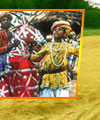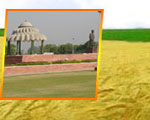|
Narnaul
The main town of the district of Mahendragarh, Narnaul dates back
to the Mahabharata as Nar Rashtra according to legend. Another one
puts it to be about 900 years old, where lions roamed free in jungles
and thus the name Naharnaul (lion’s fear).
There’s one more – one Raja Launkaran named it Narlaun
after his wife. Whichever one you choose to believe, today its called
Narnaul so we’ll call it that too.
Sher Shah Sur, the Afghan king who came in from Bihar and shook
the foundations of the Mughal dynasty, was born here. His father,
Hasan Khan, was engaged in the services of emperor Jahangir and
was the jagirdar of Narnaul. While Akbar ruled, he established a
mint here, churning out coins for the masses. The religious Satnamis
revolted against Aurangzeb’s envoy in Narnaul so severaly that
the emperor himself came down to quash the revolt.
When the Mughal dynasty disintegrated, the town was taken over
by the Rajputs and became a part of Jaipur. However, after the failed
Uprising of 1857 against the British, Narnaul passed into the hands
of the ruler of Patiala, Maharaja Narinder Singh, for helping the
Britishers.
Excursion
Jal Mahal
A building surrounded
on all sides by water, was built by Shah Quli Khan, an officer of
Akbar and the ruler of Narnaul, in1591. It represents a synthesis
of Persian and Indian architecture and stands at the centre of a
large water tank (now dry). The approach through the water was via
a causeway from the north which opens through an arched entrance.
The main building is surrounded by four minarets which have stairways
leading right to the top. However, the lower chambers have by now
disintegrated and no trace of them can be found.
Tomb of Pir Turkman
A tomb-cum-mosque complex, it belongs to a muslim saint caslled
Hazarat Turkman who setteled in these parts in the 12th century
much to the dislike of local Rathore chiefs. The original tomb is
capped by a dome, but the pillared verandah was built by the British
much later. Additions to the tomb were common even during the Mughal
period.
Tomb of Ibrahim Khan Sur
This tomb is a tribute by Sher Shah Sur, the ruler of Bengal and
later Hindustan, for his grandfather Ibrahim. The Sur who lies here
served as the administrative officer Narnaul, and the monument was
created by Sher Shah’s personal architect Sheikh Ahmad Niyazi.
The tomb is a perfect example of the Pathan style of those times.
Chor gumbad
The Chor gumbad is affectionately called the `signboard’ of
the town. Standing majestically and isolated upon a rock in the
north of the town, this gumbad is a well pplaned square building
with a large chamber within and four minarets outside at each corner.
Constructed by the Afghan Jamal Khan (as his tomb) during the reign
of Feroze Shah Tughlaq, it became a hideout for robber and thieves,
thus earning its name (chor means thief).
Tripolia gateway
Constructed by Shah Quili Khan in 1589 as the main entrance to a
garden, the gate has three sides. The Khan’s octagonal tomb
(built in red and grey sandstone) and Islam Quili Khan’s lie
within the garden complex, named Aram-i-Kausa by Quili Khan. The
gate itself is built from broken down masonry.
Chatta Rai Bal Mukund Das
A large palace built by Rai Bal Mukund Das, the diwan of Narnaul
during Emperor Shah Jahan’s reign. This five-storey building
has a number of halls, rooms and pavillions, and the Diwan-e-Khas
(inner chambers) flaunts marble floors and pillars. Fountains and
springs (they don’t work anymore) were made to keep the building
as well as the surrounding area cool in summer, the water being
sucked in from a well in the southwest. The Persian wheel was used
to lift water into reservoirs at various levels from this well so
that water could flow down at great speed. The underground chambers
(now eaten away) are believed to have had three layers wher light
streamed in throughout the day and had tunnels which lead directly
to Delhi, Jaipur and Mahendrgarh. Only a basement remains today.
Mirza Ali Jan’s Baoli
This water well or baoli was built by Mirza Ali Jan and can be found
towards the northwest of Narnaul. The Mirza was the nawab of Narnaul
while Akbar ruled. The baoli is surrounded by a mass of water called
Chotta Barwa talaab, and the main structure of the building is shaped
like a huge arched gateway carrying a takhat (bed) with a chattri
(umbrella) on top. The decorated chattri is supported by eight pillars
from where steps lead right down to a well.
Mandir Chamunda Devi
It is believed that Raja Naun Karan the ruler of the area was a
devotee of Chamunda Devi. He constructed a temple of the Devi at
the bottom of a hill. This temple is in the heart of the city. After
the fall of the regime of Raja Naun Karan, this area came under
the control of the Mughals. They built a mosque named as Jama Masjid,
the biggest masjid at Narnaul on the temple of Chamunda Devi. After
Independence, the people of this town started digging and found
the temple in torn condition. This temple is now one of the most
important and is visited by the people of the town and a big fair
is held on the occasion of Ram Naumi.
Modawala Mandir
The temple of Lord Shiva is situated at Narnaul-Rewari road near
New Bus Stand. This is the only temple of this area where every
member of the Hindu family comes for the worship of Lord Shiva and
other Hindu deities. A big fair is held here on the occasion of
Raksha Bandan.
A brief history of this temple is that tb ere was a khet (agricultural
land) and a man who was ploughing the land saw the Shiv ling during
ploughing. He heard a voice during sleep that he is the Lord Shiva
and a temple be constructed here for the benefit of the people.
Thus, this temple was built and is now a place of worship. It is
the firm belief of the people of the area that every desire is fulfilled
by Lord Shiva provided if he is worshipped or named by heart.
Top
General Information & Accomdation info on Narnaul city of Haryana
- India
|







